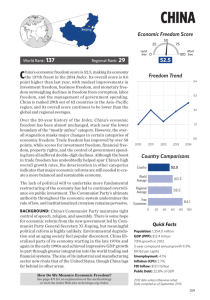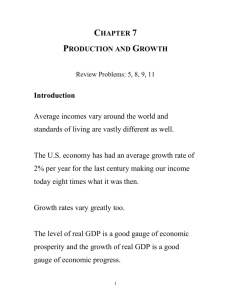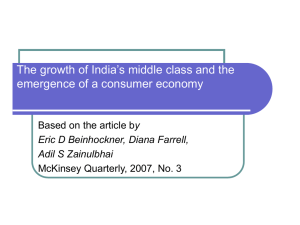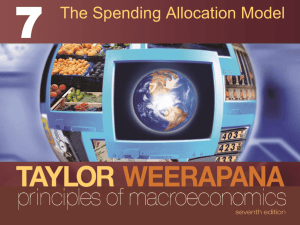25 PRODUCTION AND GROWTH
advertisement
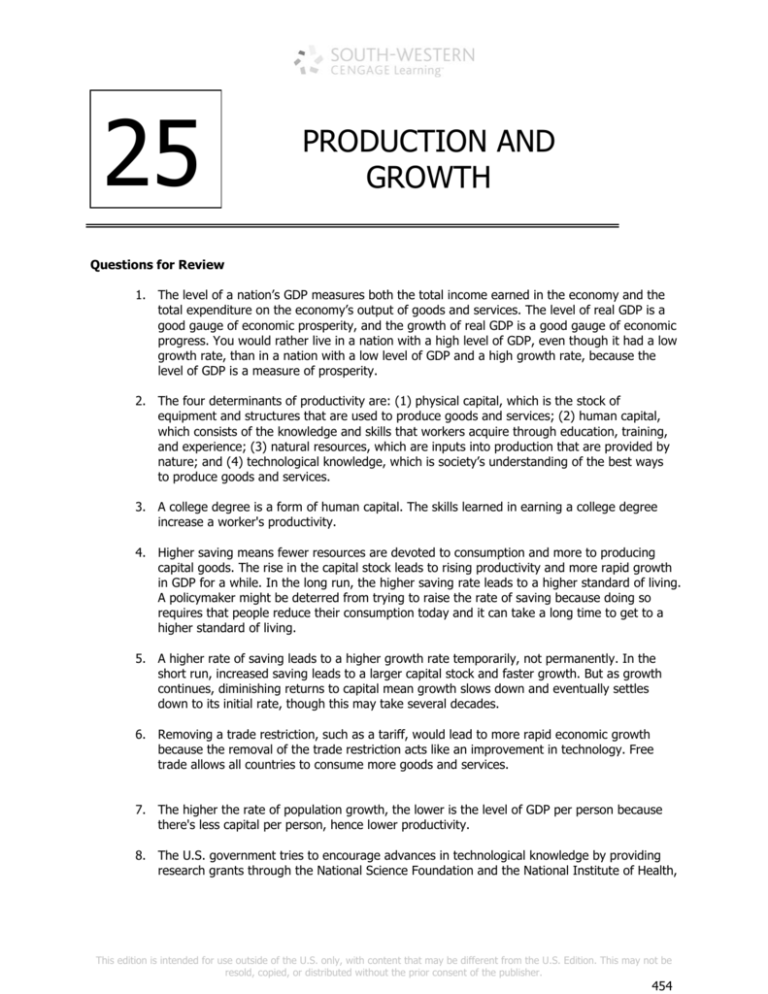
25 PRODUCTION AND GROWTH Questions for Review 1. The level of a nation’s GDP measures both the total income earned in the economy and the total expenditure on the economy’s output of goods and services. The level of real GDP is a good gauge of economic prosperity, and the growth of real GDP is a good gauge of economic progress. You would rather live in a nation with a high level of GDP, even though it had a low growth rate, than in a nation with a low level of GDP and a high growth rate, because the level of GDP is a measure of prosperity. 2. The four determinants of productivity are: (1) physical capital, which is the stock of equipment and structures that are used to produce goods and services; (2) human capital, which consists of the knowledge and skills that workers acquire through education, training, and experience; (3) natural resources, which are inputs into production that are provided by nature; and (4) technological knowledge, which is society’s understanding of the best ways to produce goods and services. 3. A college degree is a form of human capital. The skills learned in earning a college degree increase a worker's productivity. 4. Higher saving means fewer resources are devoted to consumption and more to producing capital goods. The rise in the capital stock leads to rising productivity and more rapid growth in GDP for a while. In the long run, the higher saving rate leads to a higher standard of living. A policymaker might be deterred from trying to raise the rate of saving because doing so requires that people reduce their consumption today and it can take a long time to get to a higher standard of living. 5. A higher rate of saving leads to a higher growth rate temporarily, not permanently. In the short run, increased saving leads to a larger capital stock and faster growth. But as growth continues, diminishing returns to capital mean growth slows down and eventually settles down to its initial rate, though this may take several decades. 6. Removing a trade restriction, such as a tariff, would lead to more rapid economic growth because the removal of the trade restriction acts like an improvement in technology. Free trade allows all countries to consume more goods and services. 7. The higher the rate of population growth, the lower is the level of GDP per person because there's less capital per person, hence lower productivity. 8. The U.S. government tries to encourage advances in technological knowledge by providing research grants through the National Science Foundation and the National Institute of Health, This edition is intended for use outside of the U.S. only, with content that may be different from the U.S. Edition. This may not be resold, copied, or distributed without the prior consent of the publisher. 454 Chapter 25/Production and Growth 455 with tax breaks for firms engaging in research and development, and through the patent system. Problems and Applications 1. a. More investment would lead to faster economic growth in the short run. b. The change would benefit many people in society who would have higher incomes as the result of faster economic growth. However, there might be a transition period in which workers and owners in consumption-good industries would get lower incomes, and workers and owners in investment-good industries would get higher incomes. In addition, some group would have to reduce their spending for some time so that investment could rise. 2. a. Private consumption spending includes buying food and buying clothes; private investment spending includes people buying houses and firms buying computers. Many other examples are possible. Education can be considered as both consumption and investment. b. Government consumption spending includes paying workers to administer government programs; government investment spending includes buying military equipment and building roads. Many other examples are possible. Government spending on health programs is an investment in human capital. This is truer for spending on health programs for the young rather than those for the elderly. 3. The facts that countries import many goods and services yet must produce a large quantity of goods and services themselves to enjoy a high standard of living are reconciled by noting that there are substantial gains from trade. In order to be able to afford to purchase goods from other countries, an economy must generate income. By producing many goods and services, then trading them for goods and services produced in other countries, a nation maximizes its standard of living. 4. The opportunity cost of investing in capital is the loss of consumption that results from redirecting resources toward investment. Over-investment in capital is possible because of diminishing marginal returns. A country can "over-invest" in capital if people would prefer to have higher consumption spending and less future growth. The opportunity cost of investing in human capital is also the loss of consumption that is needed to provide the resources for investment. A country could "over-invest" in human capital if people were too highly educated for the jobs they could getfor example, if the best job a Ph.D. in philosophy could find is managing a restaurant. 5. a. When a German firm opens a factory in South Carolina, it represents foreign direct investment. b. The investment increases U.S. GDP because it increases production in the United States. The effect on U.S. GNP would be smaller because the owners would get paid a return on their investment that would be part of German GNP rather than U.S. GNP. This edition is intended for use outside of the U.S. only, with content that may be different from the U.S. Edition. This may not be resold, copied, or distributed without the prior consent of the publisher. 456 Chapter 25/Production and Growth 6. a. The United States benefited from the Chinese and Japanese investment because it made our capital stock larger, increasing our economic growth. b. It would have been better for the United States to make the investments itself because then it would have received the returns on the investment itself, instead of the returns going to China and Japan. 7. Greater educational opportunities for women could lead to faster economic growth in these developing countries because increased human capital would increase productivity and there would be external effects from greater knowledge in the country. Second, increased educational opportunities for young women may lower the population growth rate because such opportunities raise the opportunity cost of having a child. 8. a. Individuals with higher incomes have better access to clean water, medical care, and good nutrition. b. Healthier individuals are likely to be more productive. c. Understanding the direction of causation will help policymakers place proper emphasis on the programs that will achieve both greater health and higher incomes. 9. a. Political stability could lead to strong economic growth by making the country attractive to investors. The increased investment would raise economic growth. b. Strong economic growth could lead to political stability because when people have high incomes they tend to be satisfied with the political system and are less likely to overthrow or change the government. 10. a. If output is rising and the number of workers is declining, then output per worker must be rising. b. Policymakers should not be concerned as long as output in the manufacturing sector is not declining. The reduction in manufacturing jobs will allow labor resources to move to other industries, increasing total output in the economy. An increase in productivity of workers (as measured by output per worker) is beneficial to the economy. This edition is intended for use outside of the U.S. only, with content that may be different from the U.S. Edition. This may not be resold, copied, or distributed without the prior consent of the publisher.





